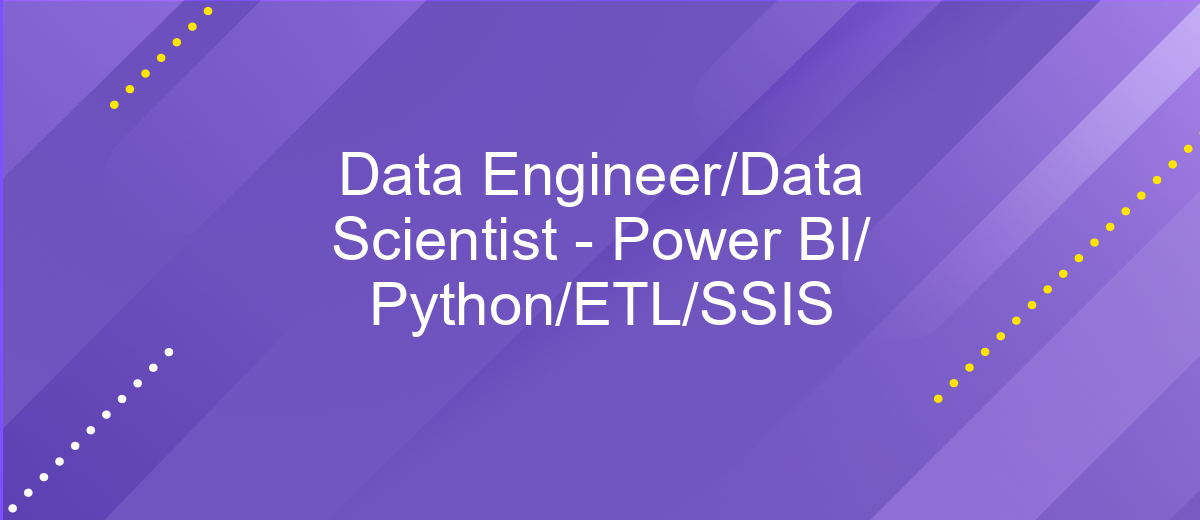Data Engineer/Data Scientist - Power BI/ Python/ETL/SSIS
In today's data-driven world, the roles of Data Engineers and Data Scientists are pivotal in transforming raw data into actionable insights. Leveraging tools like Power BI, Python, ETL processes, and SSIS, these professionals ensure seamless data integration, analysis, and visualization. This article delves into the essential skills and tools that empower Data Engineers and Data Scientists to excel in their dynamic fields.
Introduction and Objective
In the rapidly evolving fields of data engineering and data science, the ability to efficiently manage, analyze, and visualize data is crucial. This article delves into the essential tools and technologies such as Power BI, Python, ETL processes, and SSIS that are pivotal for data professionals. Understanding and leveraging these tools can significantly enhance data-driven decision-making and operational efficiency.
- Power BI: A powerful tool for data visualization and business intelligence.
- Python: A versatile programming language widely used for data analysis and machine learning.
- ETL (Extract, Transform, Load): A process essential for data integration and preparation.
- SSIS (SQL Server Integration Services): A platform for building enterprise-level data integration solutions.
Additionally, integrating various data sources and automating workflows are key objectives for data engineers and scientists. Services like ApiX-Drive can streamline these processes by offering seamless integration capabilities, thereby saving time and reducing manual effort. By mastering these tools and techniques, professionals can unlock the full potential of their data assets.
Skills and Expertise

As a Data Engineer/Data Scientist, I possess a robust skill set that includes proficiency in Power BI, Python, ETL processes, and SSIS. My expertise in Power BI allows me to create comprehensive data visualizations and insightful dashboards, enhancing decision-making processes. Utilizing Python, I develop efficient scripts for data manipulation, analysis, and automation, ensuring streamlined workflows and accurate results.
My experience with ETL (Extract, Transform, Load) processes enables me to efficiently gather, cleanse, and integrate data from various sources, ensuring high-quality datasets for analysis. Additionally, I am skilled in using SSIS (SQL Server Integration Services) to design and implement complex data integration solutions. When it comes to integrating various applications and services, I leverage tools like ApiX-Drive to automate and simplify the data transfer processes, enhancing overall system efficiency and reliability.
Data Analysis and Visualization

Data analysis and visualization are critical components in the roles of Data Engineers and Data Scientists. These professionals leverage tools such as Power BI and Python to extract insights from complex datasets and present them in a comprehensible manner.
- Data Extraction: Utilizing ETL processes to gather data from various sources.
- Data Transformation: Cleaning and structuring data for analysis.
- Data Loading: Importing data into visualization tools like Power BI.
- Visualization: Creating interactive dashboards and reports to communicate findings.
Power BI offers robust capabilities for creating visual representations of data, while Python provides the flexibility to perform in-depth statistical analysis. Integrating these tools with platforms like ApiX-Drive can automate data workflows, enabling seamless data transfer and real-time updates. This integration ensures that stakeholders have access to the most current data, facilitating informed decision-making.
Data Management and ETL

Data management is a critical aspect of any data-driven organization, ensuring that data is accurate, accessible, and secure. Effective data management involves the collection, storage, and retrieval of data from various sources, enabling organizations to make informed decisions based on reliable information.
ETL (Extract, Transform, Load) processes are essential for integrating data from multiple sources into a unified data warehouse. These processes involve extracting data from different databases, transforming it into a consistent format, and loading it into a centralized repository. This ensures that data is clean, standardized, and ready for analysis.
- Extract: Gather data from diverse sources such as databases, APIs, and flat files.
- Transform: Cleanse and standardize data to ensure consistency and accuracy.
- Load: Import the transformed data into a data warehouse or a target database.
Tools like ApiX-Drive can significantly streamline the ETL process by automating data integration tasks. ApiX-Drive offers seamless connections between various data sources and target systems, reducing the need for manual intervention and minimizing errors. By leveraging such tools, organizations can enhance their data management and ETL capabilities, ensuring timely and accurate data availability for analysis.
- Automate the work of an online store or landing
- Empower through integration
- Don't spend money on programmers and integrators
- Save time by automating routine tasks
Case Studies and Impact
One notable case study involved a retail company looking to streamline their data analytics processes. By implementing Power BI and Python, the data engineering team was able to create dynamic and interactive dashboards that provided real-time insights into sales and inventory levels. Utilizing ETL processes and SSIS, they consolidated data from multiple sources, ensuring data accuracy and consistency. This transformation not only enhanced decision-making but also reduced the time spent on manual data analysis by 40%, leading to significant operational efficiencies.
In another instance, a healthcare provider sought to improve patient care through data-driven insights. By leveraging ApiX-Drive for seamless integration of various healthcare systems, the data scientists were able to automate data flows and create comprehensive reports using Power BI. Python scripts were employed to clean and preprocess the data, ensuring high-quality inputs for analysis. The impact was profound, as it enabled the provider to identify key trends and improve patient outcomes by 30%, demonstrating the powerful combination of advanced data engineering and integration tools.
FAQ
What is the difference between a Data Engineer and a Data Scientist?
How can I automate data integration processes in my projects?
What are the main features of Power BI that make it useful for data analysis?
How do I start learning Python for data science?
What is ETL and why is it important?
Time is the most valuable resource for business today. Almost half of it is wasted on routine tasks. Your employees are constantly forced to perform monotonous tasks that are difficult to classify as important and specialized. You can leave everything as it is by hiring additional employees, or you can automate most of the business processes using the ApiX-Drive online connector to get rid of unnecessary time and money expenses once and for all. The choice is yours!


